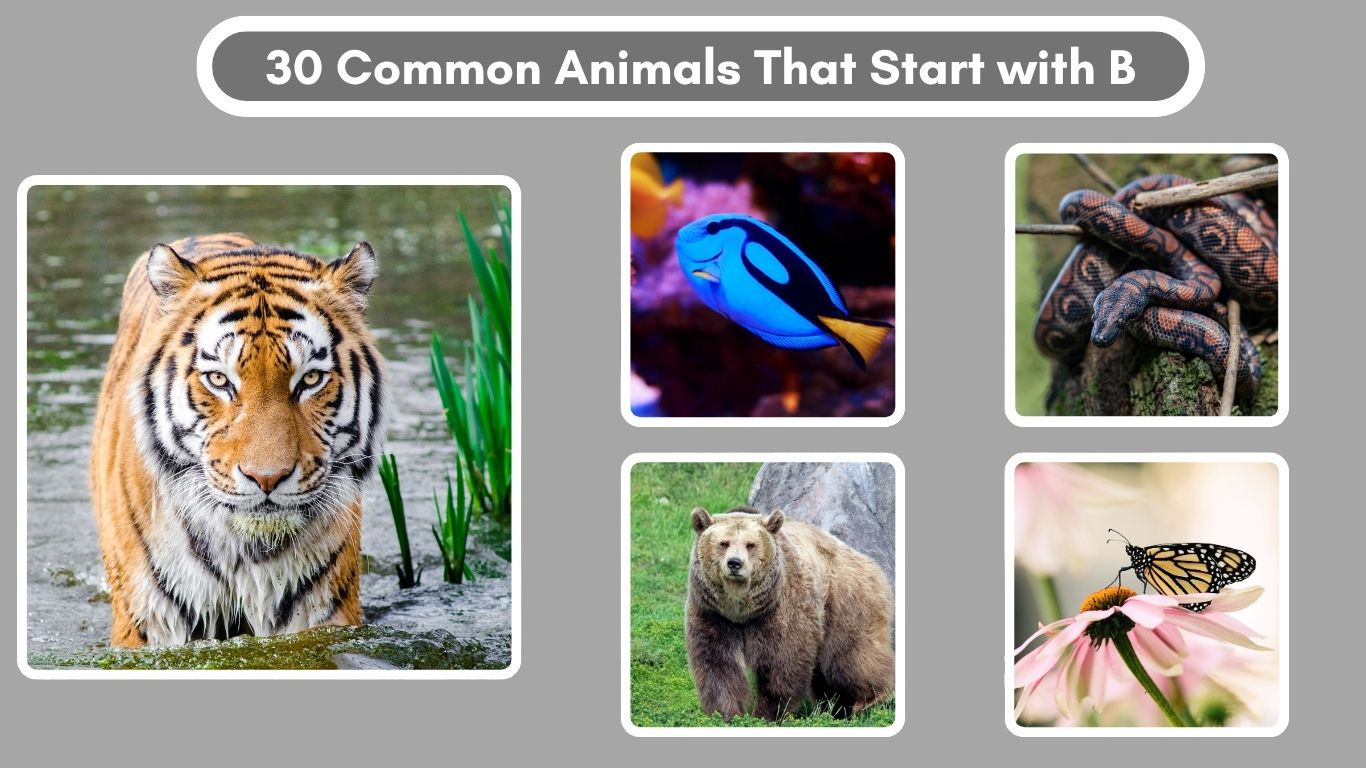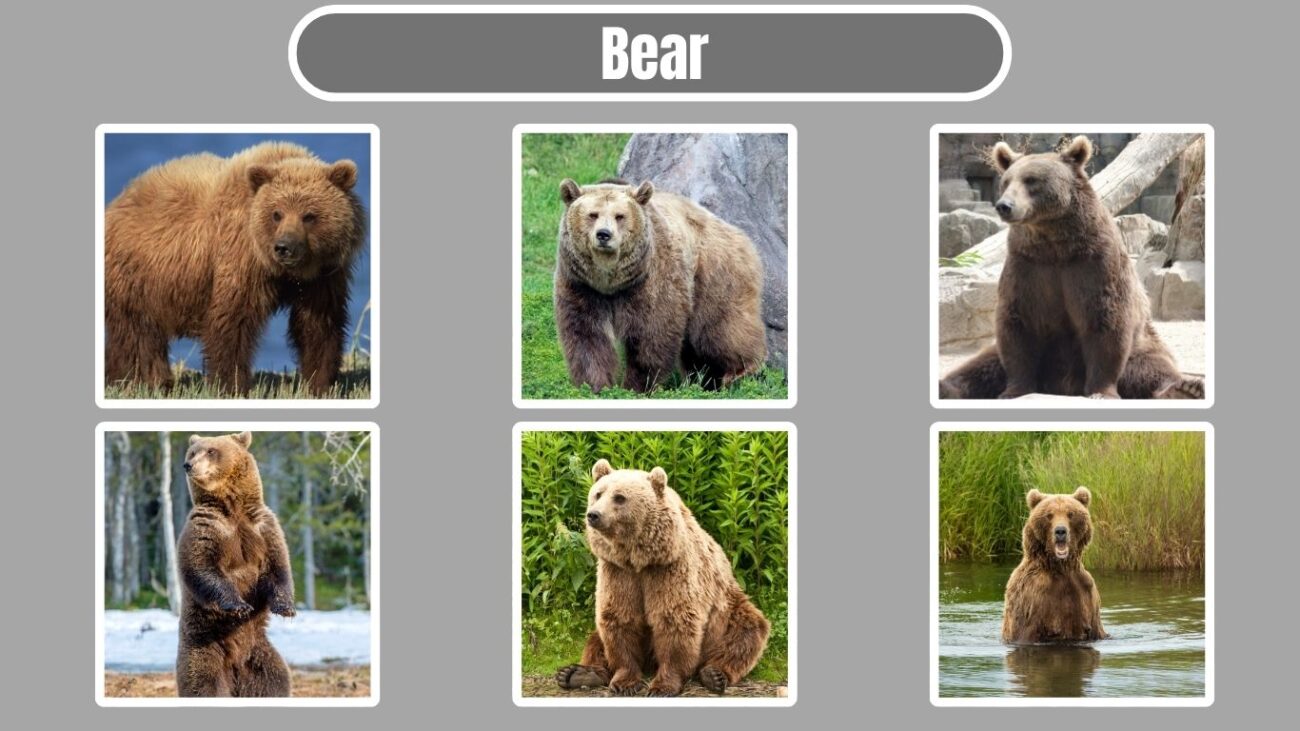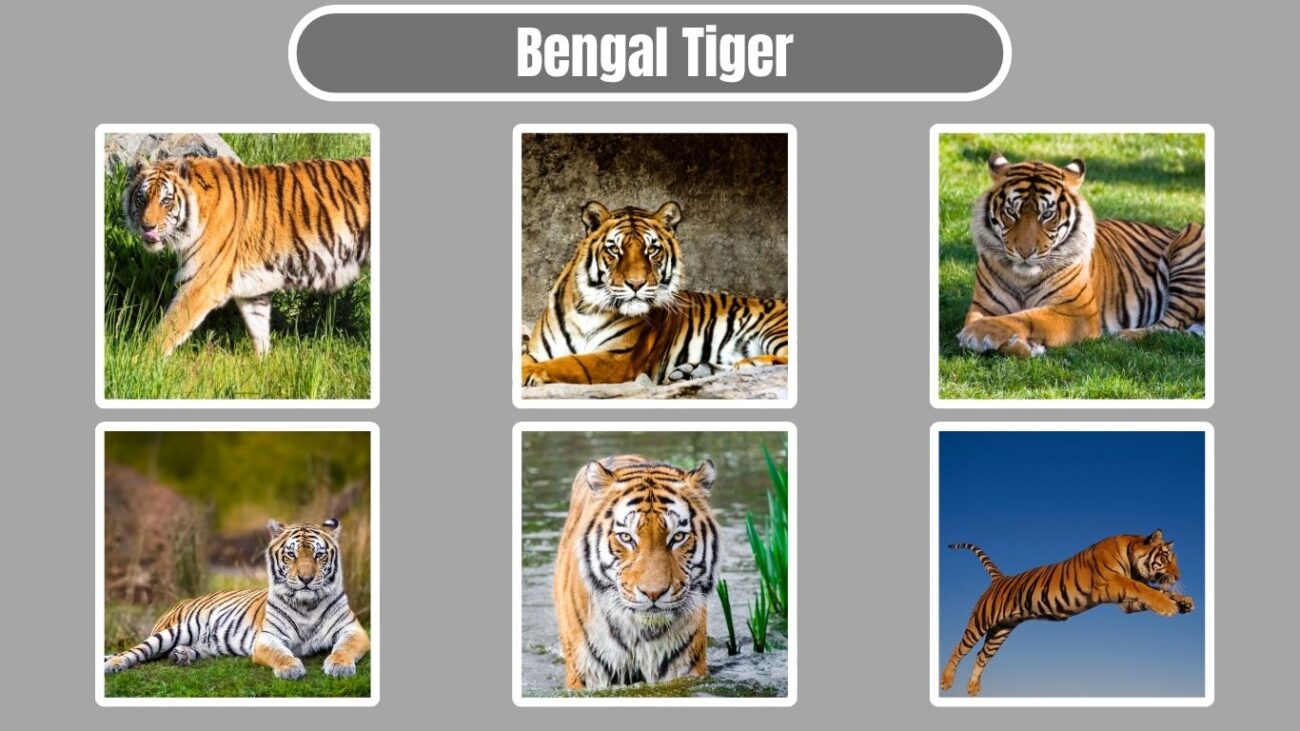The letter B begins the names of many well-known and fascinating animals from all corners of the globe. From majestic creatures like the bear and bison to tiny pollinators like the bumblebee, animals that start with “B” showcase a wide range of habitats, behaviors, and roles in nature. Whether it’s the underwater world of the barracuda or the high-flying grace of the bluebird, these animals are as diverse as they are important.
In this list, you’ll explore 30 animals that start with the letter B, including mammals, birds, reptiles, insects, and marine life. Each one contributes to the rich biodiversity of our planet in its own unique way.
1. Bear
Bears are large, powerful mammals found in forests, mountains, and tundras across North America, Europe, and Asia. Depending on the species, adult bears can weigh between 200 to over 1,000 pounds (90–450 kg). Common species include the brown bear, black bear, and polar bear.
Bears are omnivores, eating a variety of foods such as berries, fish, insects, and small mammals. Some, like polar bears, rely heavily on meat, while others eat mostly plant-based diets.
They are known for their strength, solitary nature, and ability to hibernate during winter months. Despite their intimidating size, most bears avoid human contact when possible.
2. Bat
Bats are the only mammals capable of true flight. With over 1,400 species, they’re found all over the world except in extreme deserts and polar regions. Their wings are made of a thin membrane stretched over elongated fingers.
Bats vary in size—from the tiny bumblebee bat (about 1 inch long) to the large flying fox with a wingspan over 5 feet. Most are nocturnal and use echolocation to navigate and hunt insects in the dark.
Some bats feed on fruit, nectar, or even blood (like the vampire bat), playing essential roles in pollination and insect control.
3. Bison
Bison are large, hump-backed grazing animals native to North America and parts of Europe. They can grow up to 6.5 feet (2 meters) tall at the shoulder and weigh over 2,000 pounds (900 kg). Their shaggy coats help them survive harsh winters.
American bison once roamed in massive herds across the Great Plains, but their population declined drastically in the 1800s due to overhunting. Conservation efforts have since helped their recovery.
Bison are herbivores, feeding mainly on grasses. They live in herds and are known for their strength, endurance, and importance to indigenous cultures.
4. Beaver
Beavers are large, semi-aquatic rodents known for building dams and lodges from sticks, mud, and logs. They are found in North America and Europe and have webbed hind feet and large, flat tails used for swimming and balance.
Beavers grow up to 3 feet (1 meter) long and weigh around 35–70 pounds (16–32 kg). Their powerful teeth allow them to cut down trees and shape their environment.
They are herbivores, eating bark, twigs, and aquatic plants. Beavers play a crucial role in creating wetland habitats, which benefit a wide range of other species.
5. Buffalo
Buffalo are large, hoofed mammals found in Africa and Asia. The two most well-known types are the African buffalo and the water buffalo. African buffaloes are powerful animals found in savannas and forests, while water buffaloes are domesticated and live in wetlands and rice fields.
These animals can weigh between 1,000 to 2,600 pounds (450–1,200 kg) and are known for their strength and resilience. Buffaloes are herbivores, feeding on grasses and aquatic vegetation.
They are social and live in herds. In many cultures, water buffaloes are vital for agriculture, milk production, and transportation.
6. Butterfly
Butterflies are delicate, colorful insects known for their beautiful, patterned wings and graceful flight. They belong to the order Lepidoptera and go through four life stages: egg, larva (caterpillar), pupa (chrysalis), and adult.
Found on every continent except Antarctica, butterflies inhabit gardens, meadows, forests, and even deserts. They feed on nectar from flowers using a long, coiled proboscis.
Butterflies play a vital role in pollination and are important indicators of a healthy environment. Their vibrant colors and transformation process make them a favorite in nature and education.
7. Baboon
Baboons are large, ground-dwelling monkeys native to Africa and parts of Arabia. They live in savannas, woodlands, and rocky areas and are highly social animals that form large troops with complex hierarchies.
Adult males can weigh up to 90 pounds (40 kg) and have long muzzles and large canine teeth. Baboons are omnivores, feeding on fruits, insects, small animals, and plants.
They are intelligent, vocal primates that use facial expressions and sounds for communication. While often seen near human settlements, they can become aggressive if threatened or habituated to food.
8. Blue Whale
Blue Whales are the largest animals to have ever lived on Earth. These massive marine mammals can grow up to 100 feet (30 meters) long and weigh over 180 tons. Despite their size, they feed almost exclusively on tiny shrimp-like creatures called krill.
Blue whales are found in all major oceans and migrate thousands of miles each year. They are filter feeders, using baleen plates in their mouths to strain krill from seawater.
Once nearly hunted to extinction, blue whales are now protected, though they remain endangered. Their deep, rumbling calls can be heard for hundreds of miles underwater.
9. Blue Jay
Blue Jays are bright, intelligent songbirds native to North America. They have striking blue, white, and black plumage and measure about 9 to 12 inches (23–30 cm) long. Known for their loud calls and bold personalities, blue jays are common in forests, suburbs, and city parks.
They are omnivores, feeding on seeds, nuts (especially acorns), insects, and occasionally small animals or eggs. Blue jays are known for mimicking the calls of hawks to scare off competitors.
Highly social and clever, they often cache food and exhibit strong family bonds during the breeding season.
10. Bull
Bulls are adult male cattle, typically uncastrated and known for their strength, muscular build, and sometimes aggressive behavior. They are commonly used for breeding, livestock shows, and, in some cultures, in sports such as rodeos or bullfighting.
Bulls can weigh over 2,000 pounds (900 kg), depending on the breed. They have a more robust appearance than cows and are often equipped with horns.
Domesticated for thousands of years, bulls have played a significant role in agriculture and livestock development. While powerful, they require careful handling due to their size and strength.
11. Bumblebee
Bumblebees are large, fuzzy bees known for their black-and-yellow striped bodies and gentle nature. They are found in temperate climates across North America, Europe, and Asia, living in underground nests or dense vegetation.
Bumblebees are excellent pollinators, feeding on nectar and collecting pollen to bring back to their colony. Unlike honeybees, they do not produce large quantities of honey, but they are vital for pollinating crops and wild plants.
They can sting but are not aggressive and usually only do so when threatened. Bumblebee populations are declining due to habitat loss and pesticide use, making conservation efforts increasingly important.
12. Boa Constrictor
The Boa Constrictor is a large, non-venomous snake native to Central and South America. It can grow up to 13 feet (4 meters) long and has a thick, muscular body covered in brown, tan, or cream markings that help it blend into forest and jungle habitats.
Boa constrictors are ambush predators, using their strong coils to suffocate prey such as rodents, birds, and reptiles before swallowing them whole.
They are mostly solitary and nocturnal and are also popular in the exotic pet trade due to their striking appearance and calm demeanor when handled properly.
13. Beetle
Beetles are the largest group of insects on Earth, with over 400,000 known species. They come in a wide range of sizes, colors, and shapes and are found in nearly every habitat—from forests and deserts to ponds and gardens.
All beetles have hard wing covers called elytra that protect their delicate flight wings underneath. Common examples include ladybugs, stag beetles, and dung beetles.
Beetles play a wide variety of roles in nature—some are pollinators, others decompose waste, and some are pests. They are vital to ecosystems and incredibly diverse in form and function.
14. Boxer (Dog)
The Boxer is a medium to large-sized dog breed originally developed in Germany. With a muscular build, short coat, and distinctive square jaw, boxers are known for their energetic and playful personalities.
They typically weigh between 55 to 80 pounds (25–36 kg) and are loyal, intelligent, and protective—making them excellent family companions and guard dogs.
Boxers are also used in service roles and police work. They require plenty of exercise and thrive in active households. With their expressive faces and affectionate nature, boxers are a favorite among dog lovers.
15. Barracuda
Barracudas are sleek, predatory fish found in tropical and subtropical oceans around the world. They can grow from 2 feet (60 cm) to over 6 feet (1.8 meters), depending on the species, and have long, silver bodies with sharp, fang-like teeth.
They inhabit coral reefs, open waters, and seagrass beds, where they hunt fish using bursts of speed and powerful jaws. Barracudas are known for their aggressive hunting style and excellent vision.
Although sometimes feared by swimmers due to their appearance, attacks on humans are extremely rare. They are also valued by sport fishers for their fight and size.
16. Bald Eagle
The Bald Eagle is a powerful bird of prey and the national symbol of the United States. It is easily recognized by its white head and tail, contrasting with a dark brown body and wings. Adults have a wingspan of up to 7 feet (2.1 meters) and strong, hooked beaks.
Bald eagles are found near rivers, lakes, and coastal regions across North America. They feed mainly on fish, which they snatch from the water with sharp talons, but they also eat small mammals and carrion.
After facing decline due to pesticide use, conservation efforts helped restore their numbers, making the bald eagle a success story in wildlife recovery.
17. Bactrian Camel
The Bactrian Camel is a large mammal native to the deserts and steppes of Central Asia. Unlike the dromedary camel, which has one hump, the Bactrian camel has two humps used to store fat for energy during food shortages.
They are extremely hardy and well-adapted to harsh environments with extreme temperatures. Their thick coats protect them from cold, and their broad, padded feet allow them to walk across sand and rocky terrain.
Used by humans for centuries as pack animals and sources of milk, wool, and meat, Bactrian camels remain vital to nomadic cultures in Asia.
18. Bengal Tiger
The Bengal Tiger is one of the most iconic and powerful big cats in the world. Native to India, Bangladesh, Nepal, and Bhutan, it features a striking orange coat with black stripes and a white underbelly. Adult males can weigh over 500 pounds (227 kg).
Bengal tigers are solitary and territorial, living in forests, mangroves, and grasslands. They are apex predators, feeding on deer, wild boar, and other large prey.
Though revered and protected, they face threats from habitat loss and poaching. Conservation programs have helped stabilize some populations, but they remain classified as endangered.
19. Bonobo
Bonobos are one of humans’ closest relatives, sharing over 98% of our DNA. They are native to the Democratic Republic of the Congo and are often confused with chimpanzees but are generally smaller and more peaceful.
Bonobos live in matriarchal societies and are known for their strong social bonds, empathy, and use of sexual behavior to resolve conflicts. They measure about 3 feet (90 cm) tall and weigh between 65–85 pounds (30–39 kg).
They are omnivores, eating mainly fruit, leaves, and occasionally small animals. Bonobos are endangered due to deforestation and hunting.
20. Bullfrog
Bullfrogs are large amphibians native to North America, particularly the eastern United States. They can grow up to 8 inches (20 cm) long and weigh over a pound (0.5 kg). They are named for their deep, bellowing call, which resembles a bull’s roar.
Bullfrogs live near ponds, lakes, and marshes and are both aquatic and terrestrial. They are carnivorous and highly opportunistic, feeding on insects, fish, birds, and even other frogs.
Due to their aggressive nature and adaptability, bullfrogs have become invasive in some regions, where they outcompete and prey on native species.
21. Barn Owl
The Barn Owl is a widespread and easily recognizable bird of prey known for its heart-shaped face, pale plumage, and eerie, screeching call. Found on every continent except Antarctica, it thrives in open habitats like farmlands, grasslands, and the edges of woodlands.
Barn owls grow about 12 to 15 inches (30–38 cm) tall and hunt mainly at night, using exceptional hearing to detect small mammals like mice and voles even in complete darkness.
They nest in barns, tree cavities, and man-made boxes. As natural pest controllers, barn owls are highly beneficial to agriculture and are a symbol of silent, efficient hunting.
22. Barnacle
Barnacles are small, hard-shelled marine crustaceans that attach themselves permanently to rocks, ships, whales, piers, and other surfaces in the ocean. Though they may look like tiny seashells, they are more closely related to crabs and lobsters.
They live in intertidal zones and filter plankton and debris from the water using feathery appendages. Barnacles have one of the strongest natural adhesives, allowing them to cling tightly even in rough waters.
While harmless, large barnacle colonies can cause issues for boats and marine equipment. They play an important role in coastal ecosystems by filtering water and providing habitat for other small organisms.
23. Black Widow Spider
The Black Widow Spider is one of the most well-known venomous spiders, easily identified by its shiny black body and the distinctive red hourglass marking on the underside of the female’s abdomen. Females are larger than males, growing up to 1.5 inches (38 mm) including legs.
They are found in warm climates around the world, often hiding in dark, undisturbed places like woodpiles, sheds, or under rocks. Black widows spin irregular, tangled webs and feed on insects that get trapped.
While their bite can cause pain and symptoms like muscle cramps, it is rarely fatal to healthy humans. Still, medical attention is advised after a bite.
24. Blue Tang
The Blue Tang is a vibrant, reef-dwelling fish made famous by the character “Dory” in Finding Nemo. It features a royal blue body with a bold black pattern and a bright yellow tail. Adults grow up to 12 inches (30 cm) long.
Found in coral reefs in the Indo-Pacific, blue tangs are active during the day and feed primarily on algae. Their constant grazing helps keep coral reefs healthy and balanced.
Though popular in aquariums, they require special care and large tanks due to their swimming needs and territorial behavior. They are also known for sharp spines on their tails used for defense.
25. Bluebird
Bluebirds are small, colorful songbirds native to North America. They are most recognized for their brilliant blue plumage and reddish-orange breasts. Common species include the Eastern Bluebird, Western Bluebird, and Mountain Bluebird.
They prefer open fields, meadows, and woodland edges, often nesting in tree cavities or nest boxes. Bluebirds are insectivores, feeding on beetles, caterpillars, crickets, and occasionally berries.
Known for their gentle song and vibrant appearance, bluebirds are also symbols of happiness and hope. Conservation efforts, especially the installation of nest boxes, have helped restore their declining populations.
26. Binturong
The Binturong, also known as the bearcat, is a large, tree-dwelling mammal native to the rainforests of Southeast Asia. It has a shaggy black coat, long bushy tail, and a face that resembles a mix between a bear and a cat. Adults can grow up to 3 feet (90 cm) long, excluding the tail.
Binturongs are nocturnal and primarily arboreal, using their prehensile tails for climbing. They are omnivores, feeding on fruit, small animals, insects, and eggs.
One of their most curious traits is their scent—they smell like buttered popcorn due to a chemical they secrete for marking territory. Binturongs are shy and solitary and face threats from habitat loss and hunting.
27. Black Bear
Black Bears are medium-sized bears native to North America, found in forests, swamps, and mountainous regions. Despite their name, they can be black, brown, cinnamon, or even white in rare cases. Adults typically weigh 200–600 pounds (90–270 kg).
Black bears are omnivores, eating berries, nuts, roots, insects, fish, and small mammals. They are excellent climbers and swimmers and are generally shy around humans unless habituated to food.
During winter, black bears hibernate in dens, surviving off body fat. Though not usually aggressive, they can be dangerous if startled or protecting cubs.
28. Bush Baby
Bush Babies, or galagos, are small, nocturnal primates native to Africa. They have large eyes for night vision, powerful legs for jumping, and long tails for balance. Most species are only 5 to 12 inches (12–30 cm) in body length, not including the tail.
They live in forests and woodlands and are highly agile, leaping between trees with ease. Their diet includes insects, fruit, tree sap, and small vertebrates.
Bush babies communicate using high-pitched calls and scent markings. Their big-eyed, teddy bear-like appearance makes them look cute, but they are wild animals best left in their natural habitat.
29. Booby (Bird)
Boobies are large, tropical seabirds found mainly along the coasts of the Pacific Ocean and islands like the Galápagos. Known for their clumsy land movements, they are graceful and skilled fliers and divers at sea. Common types include the Blue-footed Booby, Red-footed Booby, and Masked Booby.
They feed primarily on fish and squid, plunging from the air into the water at high speeds. Their name comes from the Spanish word bobo, meaning “fool,” due to their tame nature and awkwardness on land.
Boobies nest in colonies and are known for their quirky mating dances, especially the foot-lifting display of the Blue-footed Booby.
30. Bandicoot
Bandicoots are small to medium-sized marsupials native to Australia and New Guinea. They resemble a mix between a rat and a rabbit, with pointed snouts, rounded ears, and long hind legs. Most bandicoots grow about 10–20 inches (25–50 cm) long.
They are nocturnal and solitary, digging with their front claws to search for insects, worms, roots, and seeds. Bandicoots are omnivorous and use their sharp noses to forage.
They live in woodlands, grasslands, and scrub areas. Some species are endangered due to habitat destruction and introduced predators like cats and foxes. Despite their shy nature, bandicoots are important for soil health through their digging behavior.






